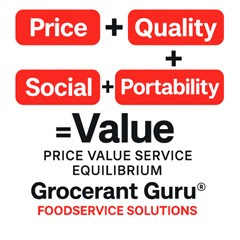A look at how one federal policy change may unravel the traditional food ecosystem, fueling black-market bodegas and overwhelming food banks across the country from the minds-eye of Steven Johnson Grocerant Guru® at Tacoma, WA based Foodservice Solutions®.
The
U.S. food industry is no stranger to disruption — from automation and delivery
apps to the COVID-19 pandemic. But a quieter, more seismic shift is unfolding
beneath the surface, threatening to gut traditional grocery stores and fracture
food access for millions. The trigger? A controversial policy change: “Agriculture
Secretary blocks SNAP benefits for undocumented immigrants”, following a $186
billion federal budget cut to the program.
At
first glance, this appears to be just another political maneuver. But in
reality, it may accelerate a long-brewing undercurrent that could collapse
legacy grocers, overrun food banks, and create a shadow economy of underground
food supply networks. Here's how.
SNAP’s Central Role in Retail Food Economics
The
Supplemental Nutrition Assistance Program (SNAP) is not just a social
safety net — it’s a backbone of the American grocery economy. Over 41
million people in the U.S. depend on SNAP to buy groceries, spending tens
of billions of dollars annually at retail food outlets. In fact, one in
every eight dollars spent in grocery stores is tied to SNAP.
Legacy
grocery stores — especially regional chains and rural supermarkets — depend
heavily on SNAP dollars. These stores are already operating on razor-thin
margins (typically 1–2%). The abrupt removal of millions of undocumented
immigrants from SNAP eligibility — and deeper program-wide budget cuts — risks cutting
out large swaths of revenue from fragile stores, particularly in low-income
and immigrant-heavy communities.
The Coming Crisis: What Grocery Stores Stand to Lose
1. Loss
of SNAP-dependent foot traffic: Many low-income shoppers cluster
their spending around SNAP availability dates. The reduction of eligible
recipients means fewer store visits and smaller baskets.
2. Rural
and urban food deserts will widen: Small-town grocers, already sparse,
rely disproportionately on government-backed spending. Their closure will leave
vast food deserts behind.
3. Accelerated
bankruptcies: We’ve already seen legacy names like
Safeway, Winn-Dixie, and Kroger shutter locations. These cuts could push more
of them over the edge — particularly in lower-income ZIP codes.
4. Job
losses: Retail grocery employs more than 3 million workers
nationwide. As stores close, low-wage workers (many of whom are SNAP recipients
themselves) may be pushed into deeper economic instability.
Rise of the Underground Bodega
History
shows that when access to necessities is restricted, alternative economies
arise. With SNAP restrictions tightening, and the formal food industry
crumbling in some neighborhoods, informal bodegas, pop-up street vendors,
and even black-market food sales may fill the gap.
These
underground markets may:
·
Operate outside regulatory oversight
(health, safety, taxation)
·
Sell expired, diverted, or surplus
goods at inflated or under-market prices
·
Become essential for undocumented or
unbanked communities, who now face barriers to both income and nutrition
This
is not speculative: During past economic downturns and crises, similar
phenomena emerged in cities from New York to Los Angeles — informal corner
stores selling basics like rice, beans, diapers, and medicine, often in
cash-only environments.
Food Banks: The Final Failing Line of Defense
Already
overwhelmed post-pandemic, food banks across the U.S. are stretched thin. They
rely on federal funding, private donations, and surplus grocery stock. But if
grocery stores begin to disappear — and government dollars shrink — food banks
could face:
·
Unprecedented demand surges
·
Supply shortages
as stores collapse and fewer manufacturers offload overstock
·
A surge in undocumented individuals
and families seeking food support for which they
now don’t qualify
This
perfect storm could break the backs of organizations that serve as the last
resort for food-insecure Americans.
The Bigger Picture: A Two-Tiered Food Economy
The
SNAP cuts — especially those targeting undocumented immigrants — don't occur in
a vacuum. They redefine the structure of who gets access to food and how.
What emerges is a two-tiered food economy:
·
Tier 1:
Affluent, documented consumers shopping at corporate chains and using digital
payment platforms.
·
Tier 2:
A shadow food network of unregulated bodegas, informal barter, and
community-led relief operations — mostly serving the marginalized,
undocumented, and destitute.
It’s
a division not only of class, but legality. And it’s being etched into the
American food system, brick by invisible brick.
Final Thoughts: A Silent Shift With Loud Consequences
While
the recent SNAP cuts are framed as fiscal conservatism, they may ignite a
structural collapse in the food industry that reverberates far beyond the
checkouts. Traditional grocers, already strained, are now bleeding vital
revenue. Simultaneously, millions of the most vulnerable are pushed out of
official support systems and into informal, potentially unsafe alternatives.
If
this trajectory continues unchecked, the U.S. could soon see a bifurcated
food economy: gleaming, digitally optimized supermarkets for some — and
black-market bread lines for the rest.
And
once legacy grocery chains collapse under the weight of these changes, it may
be too late to rebuild what was lost.
Drive Sales. Boost Profits. Stay a Step Ahead.
The
Foodservice Solutions® team is dedicated to helping you grow your
top-line sales and bottom-line profits.
Are
you looking a customer ahead? We have the strategies to get you there.
🌎
Visit GrocerantGuru.com
📩 Contact us: Steve@FoodserviceSolutions.us







.jpg)

No comments:
Post a Comment